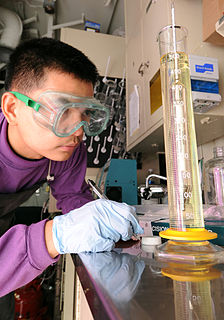
Relative density, or specific gravity, is the ratio of the density of a substance to the density of a given reference material. Specific gravity for liquids is nearly always measured with respect to water at its densest ; for gases, air at room temperature in the reference. The term "relative density" is often preferred in scientific usage. It is defined as a ratio of density of particular substance with that of water.

A drop or droplet is a small column of liquid, bounded completely or almost completely by free surfaces. A drop may form when liquid accumulates at the lower end of a tube or other surface boundary, producing a hanging drop called a pendant drop. Drops may also be formed by the condensation of a vapor or by atomization of a larger mass of liquid.

A Petri dish is a shallow transparent lidded dish that biologists use to culture cells, such as bacteria, fungi or small mosses. It is the most common type of culture plate.

A wine bottle is a bottle, generally made of glass, that is used for holding wine. Some wines are fermented in the bottle, others are bottled only after fermentation. Recently the bottle has become a standard unit of volume to describe sales in the wine industry, measuring 750 millilitres. Wine bottles are produced, however, in a variety of volumes and shapes.
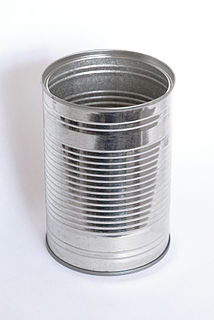
A steel can, tin can, tin , steel packaging, or can is a container for the distribution or storage of goods, made of thin metal. Many cans require opening by cutting the "end" open; others have removable covers. Cans hold diverse contents: food, beverages, oil, chemicals, etc. Steel cans are made of tinplate or of tin-free steel. In some dialects, even aluminium cans are called "tin cans".
Glass tubes are mainly cylindrical hollow-wares. Their special shape combined with the huge variety of glass types, allows the use of glass tubing in many applications. For example, laboratory glassware, lighting applications, solar thermal systems and pharmaceutical packaging to name the largest.

An ampoule is a small sealed vial which is used to contain and preserve a sample, usually a solid or liquid. Ampoules are made of glass.
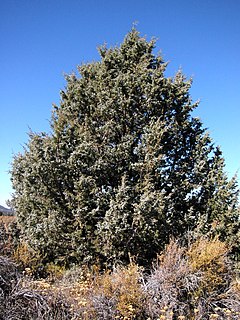
Juniperus occidentalis, known as the western juniper, is a shrub or tree native to the western United States, growing in mountains at altitudes of 800–3,000 metres (2,600–9,800 ft) and rarely down to 100 metres (330 ft). It is listed as Least Concern on the IUCN Red List because it is a widespread species with an increasing population.

Eupomatia is a genus of three flowering shrub species known to science, of the Australian continent ancient family Eupomatiaceae. The Eupomatiaceae have been recognised by most taxonomists and classified in the plant order Magnoliales. The three species of shrubs or small trees grow naturally in the rainforests and humid eucalypt forests of eastern Australia and New Guinea. The type species Eupomatia laurina was described in 1814 by Robert Brown.
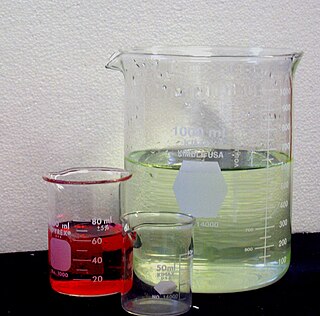
A beaker is generally a cylindrical container with a flat bottom. Most also have a small spout to aid pouring, as shown in the picture. Beakers are available in a wide range of sizes, from one millilitre up to several litres. A beaker is distinguished from a flask by having straight rather than sloping sides. The exception to this definition is a slightly conical-sided beaker called a Philips beaker.

Ground glass joints are used in laboratories to quickly and easily fit leak-tight apparatus together from commonly available parts. For example, a round bottom flask, Liebig condenser, and oil bubbler with ground glass joints may be rapidly fitted together to reflux a reaction mixture. This is a large improvement compared with older methods of custom-made glassware, which was time-consuming and expensive, or the use of less chemical resistant and heat resistant corks or rubber bungs and glass tubes as joints, which took time to prepare as well.
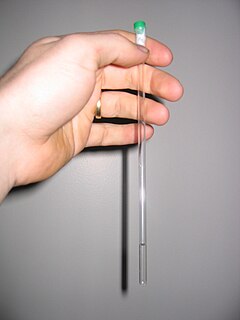
An NMR tube is a thin glass walled tube used to contain samples in nuclear magnetic resonance spectroscopy. Typically NMR tubes come in 5 mm diameters but 10 mm and 3 mm samples are known. It is important that the tubes are uniformly thick and well-balanced to ensure that NMR tube spins at a regular rate, usually about 20 Hz in the NMR spectrometer.
Standard battery nomenclature describes portable dry cell batteries that have physical dimensions and electrical characteristics interchangeable between manufacturers. The long history of disposable dry cells means that many different manufacturer-specific and national standards were used to designate sizes, long before international standards were reached. Technical standards for battery sizes and types are set by standards organizations such as International Electrotechnical Commission (IEC) and American National Standards Institute (ANSI). Popular sizes are still referred to by old standard or manufacturer designations, and some non-systematic designations have been included in current international standards due to wide use.

Nessler cylinders are laboratory tubes with a fixed volume, made of glass with optically plane bottom. On the walls there are marks of the nominal stroke volume and possibly one half-way mark
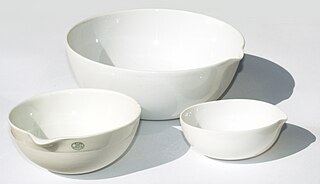
An evaporating dish is a piece of laboratory glassware used for the evaporation of solutions and supernatant liquids, and sometimes to their melting point. Evaporating dishes are used to evaporate excess solvents – most commonly water – to produce a concentrated solution or a solid precipitate of the dissolved substance.

A bottle kiln, or bottle oven, is a type of kiln. The word 'bottle' refers to the shape of the structure and not to the kiln's products, which are usually pottery, not glass.
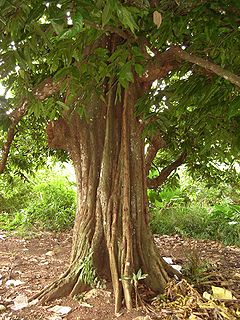
Inocarpus fagifer, commonly known as the Tahitian chestnut, Polynesian chestnut, aila or mape tree, is a species of flowering plant in the subfamily Faboideae of the legume family, Fabaceae. The tree has a wide range in the tropics of the south-west Pacific and south-east Asian regions, and a history of traditional use by the peoples of Polynesia and Melanesia. It is the only edible and culturally important member of the genus Inocarpus.
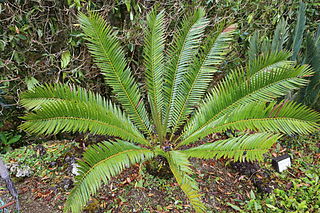
Encephalartos equatorialis is a species of cycad that is found on two granite hills on the eastern shore of Thurston Bay, Lake Victoria, Uganda at elevations up to 1000 meters.

The Kalemba Rockshelter is an archaeology site located in eastern Zambia, at coordinates 14°7 S and 32°3 E. Local tradition recalls the use of the rock shelter as a refuge during the time of Ngoni raiding in the 19th century. The site is known for various rock paintings as well as advanced microlithic use.

Acacia undulifolia is a shrub of the genus Acacia and the subgenus Phyllodineae that is endemic to eastern Australia.

















